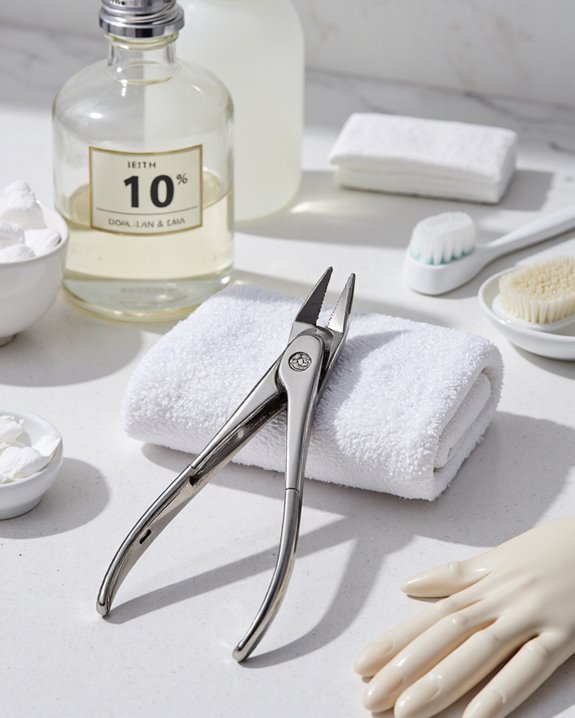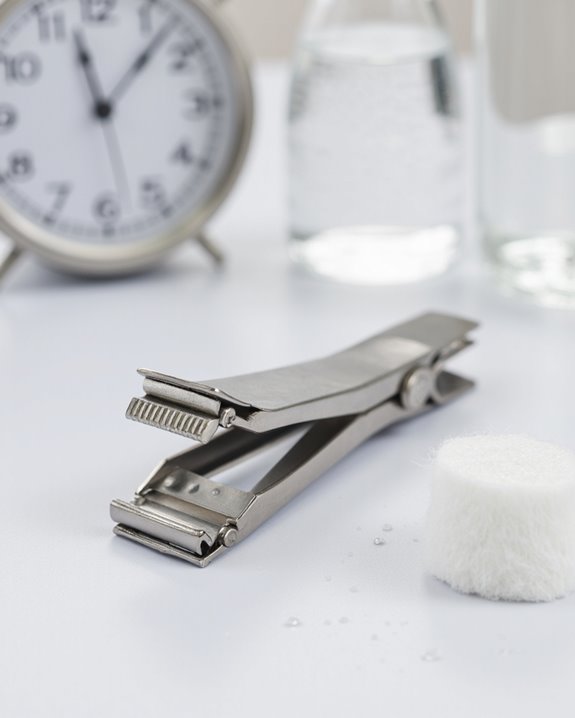To disinfect nail clippers effectively, start by removing visible debris with a soft brush. Second, scrub the clippers with warm, soapy water, focusing on crevices and joints. Third, submerge them in 70% isopropyl alcohol for 30 minutes to kill germs. Fourth, thoroughly dry the clippers with a clean cloth to prevent rust. Finally, store them in a sealed plastic bag in a dry location. Proper maintenance extends clipper lifespan while preventing potential infections.
Key Takeaways
- Remove visible debris with a soft-bristled brush and mild soap solution.
- Soak clippers in 70% isopropyl alcohol for 30 minutes to kill bacteria and fungi.
- Rinse thoroughly under running water to remove all disinfectant residue.
- Dry completely with a clean cloth or paper towel to prevent rust formation.
- Store in a sealed plastic bag in a dry location to maintain cleanliness between uses.
Preparing Your Nail Clippers for Cleaning
Five essential supplies are needed to properly prepare nail clippers for disinfection: a soft-bristled brush, mild soap, rubbing alcohol, cotton balls, and a clean cloth. Before beginning the cleaning process, users should disassemble their nail clippers if they have removable parts, allowing better access to hard-to-reach areas where bacteria may accumulate. The initial preparation involves using a cloth to wipe away visible dead skin and nail remnants from the clipper surfaces, effectively removing debris that could interfere with thorough disinfection. For more stubborn buildup in crevices, a toothpick or tweezers can carefully dislodge trapped particles. Once loose debris is cleared, the clippers should be scrubbed with the bristle brush and mild soap, creating a clean foundation for the subsequent disinfection process.
Removing Debris and Surface Contaminants
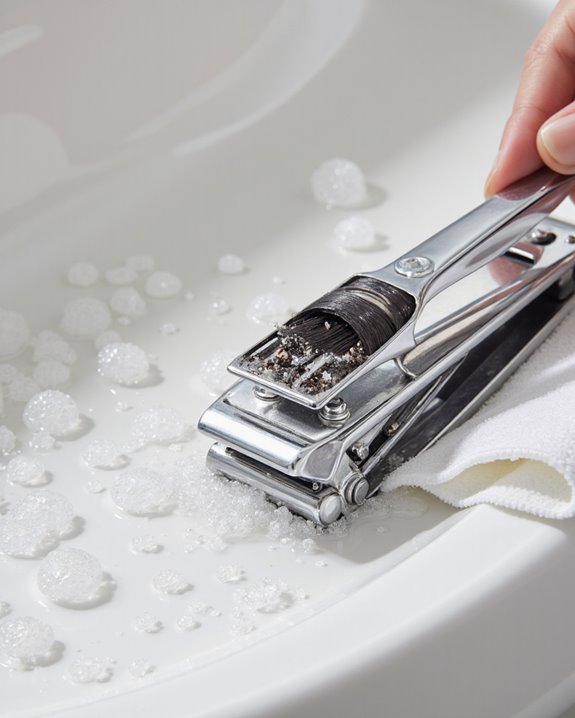
Properly removing debris and surface contaminants constitutes the first critical step in the nail clipper disinfection process, ensuring that subsequent sanitization can effectively reach all surfaces. Begin by using a clean, dry cloth to wipe away visible nail clippings and particles that accumulate on the tool’s surfaces. For stubborn residue in crevices, employ tools such as toothpicks or tweezers to dislodge built-up gunk that could harbor bacteria.
Next, prepare a solution of warm water and soap or dishwashing liquid to soak the nail clippers for 5-10 minutes, loosening embedded contaminants. After soaking, utilize a soft-bristled brush to thoroughly scrub all components, paying particular attention to cutting edges and joints. Complete this phase by rinsing the clippers under running water to remove any remaining soap residue before proceeding to disinfection. Additionally, ensuring proper cleaning with a disinfectant-compatible solution helps to prevent microbial buildup and enhances overall sterilization effectiveness.
Applying Disinfectant Solutions Effectively
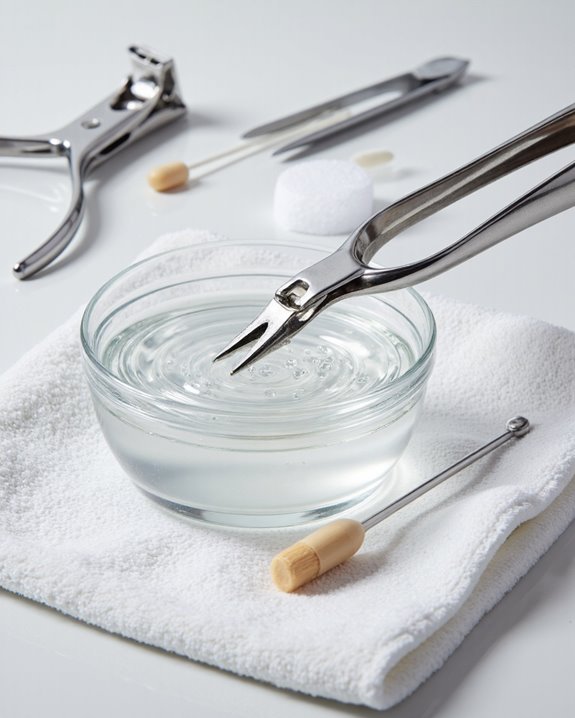
After thoroughly cleaning the nail clippers, the next step involves applying appropriate disinfectant solutions, which directly kills germs and prevents potential infections. For best results, use a 70% isopropyl alcohol solution or hydrogen peroxide as effective options to sanitize your nail clippers. When disinfecting your nail clippers, make sure they remain fully submerged in the solution for the required duration—30 minutes for isopropyl alcohol and at least 5 minutes for hydrogen peroxide. For enhanced antimicrobial action, consider combining rubbing alcohol and hydrogen peroxide in equal parts, soaking clippers in the solution for 10-15 minutes. Alternatively, a 10% chlorine bleach solution provides thorough disinfection when clippers are immersed for 30 minutes. Following CDC guidelines, prepare fresh disinfectant solutions each time to maximize effectiveness against pathogens. Incorporating disinfection efficacy can help ensure your tools are completely sanitized and safe for use.
Drying and Storing Sanitized Clippers
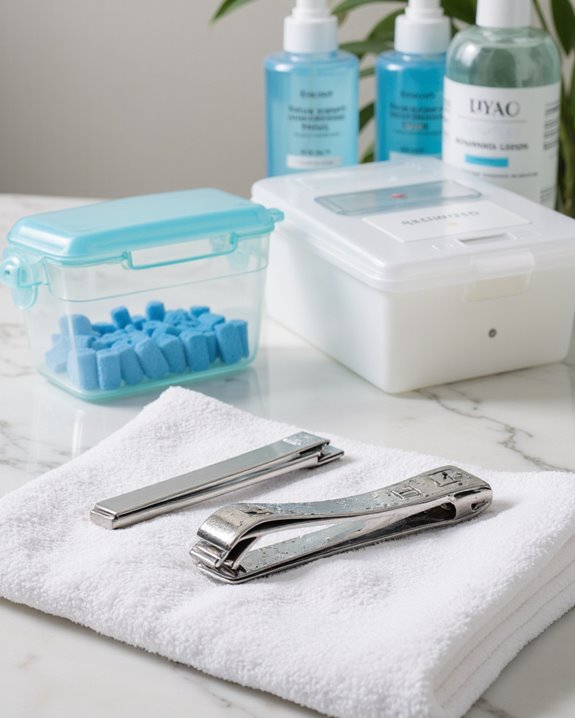
The final step in the disinfection process, drying and storing the nail clippers properly, plays an essential role in maintaining their sanitation and preventing potential health hazards. After disinfection, make sure clippers are completely dry using a paper towel or hair dryer, as moisture promotes rust formation and bacterial growth within days, particularly in humid environments. A thorough drying with a dry cloth eliminates residual moisture that could compromise tool integrity during storage. Additionally, using lint-free wipes helps prevent lint residue that could harbor bacteria or interfere with the cleanliness of the tools.
For ideal dry storage, place the sanitized implements in a sealed zip-style bag to maintain clean conditions and prevent recontamination. Store this bag in a designated container or bowl kept in a clean and hygienic location. Regular inspection of stored clippers helps identify potential moisture issues early, extending tool life while ensuring they remain bacteria-free between uses.
Maintaining Regular Clipper Hygiene Routine
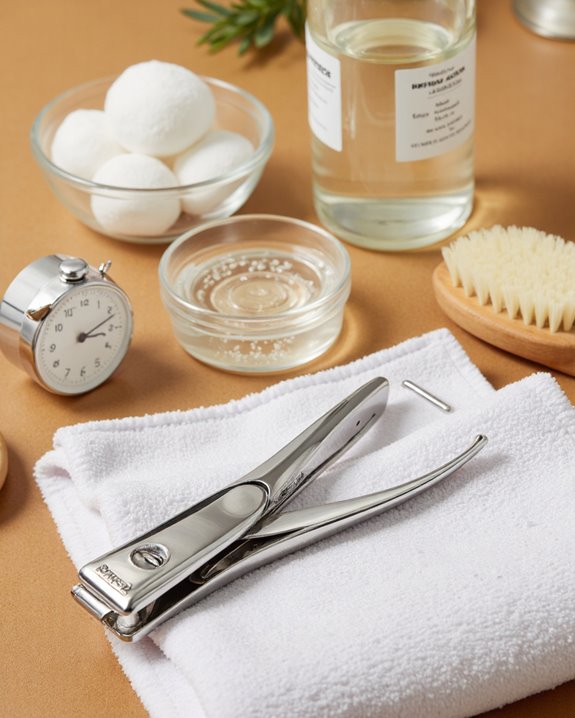
Establishing a consistent hygiene routine for nail clippers represents a fundamental practice for preventing potential infections and extending the lifespan of these personal care tools. Experts recommend users disinfect their clippers with 70% isopropyl alcohol at least once a month, incorporating a 30-minute soaking period to effectively destroy pathogens that may accumulate on nail tools. After each use, properly sanitized clippers should be wiped with a clean cloth and stored in a sealed plastic bag in a dry environment, preventing rust and mold growth. Maintaining clean clippers requires regular inspection for signs of dullness or corrosion, with prompt replacement when necessary. Following CDC guidelines for clean and sanitize procedures minimizes the risk of infections, ensuring that nail care remains safe through clippers regularly subjected to thorough sanitization protocols.
Frequently Asked Questions
What Is the Best Way to Disinfect Nail Clippers?
Disinfecting nail clippers effectively involves soaking in 70% isopropyl alcohol for 30 minutes. While boiling method, UV sterilization, bleach solution, vinegar rinse, and heat disinfection exist, alcohol immersion remains superior to soap cleaning or manual scrubbing for routine maintenance.
Does Alcohol Disinfect Nail Clippers From Fungus?
Yes, 70% isopropyl alcohol effectively disinfects nail clippers from fungus when soaked for 30 minutes. This Hygiene Basic prevents Fungus Spread by denaturing proteins in fungal cells, making it a reliable Tool Maintenance practice.
Can Hydrogen Peroxide Disinfect Nail Clippers?
Gleaming metal, bubbling solution—hydrogen peroxide effectively disinfects nail clippers. Its bacterial effects and viral prevention capabilities guarantee tool hygiene through proper disinfectant process. Five-minute soaking provides hydrogen efficacy while supporting routine maintenance and clippers care.
How to Disinfect Nail Clippers From Fungus Reddit?
Reddit threads on nail clipper disinfection debunk fungus myths while sharing user stories. Community advice emphasizes prevention tips like hydrogen peroxide soaking, proper clip storage, and daily maintenance with natural remedies to reduce fungal risks through consistent hygiene habits.

